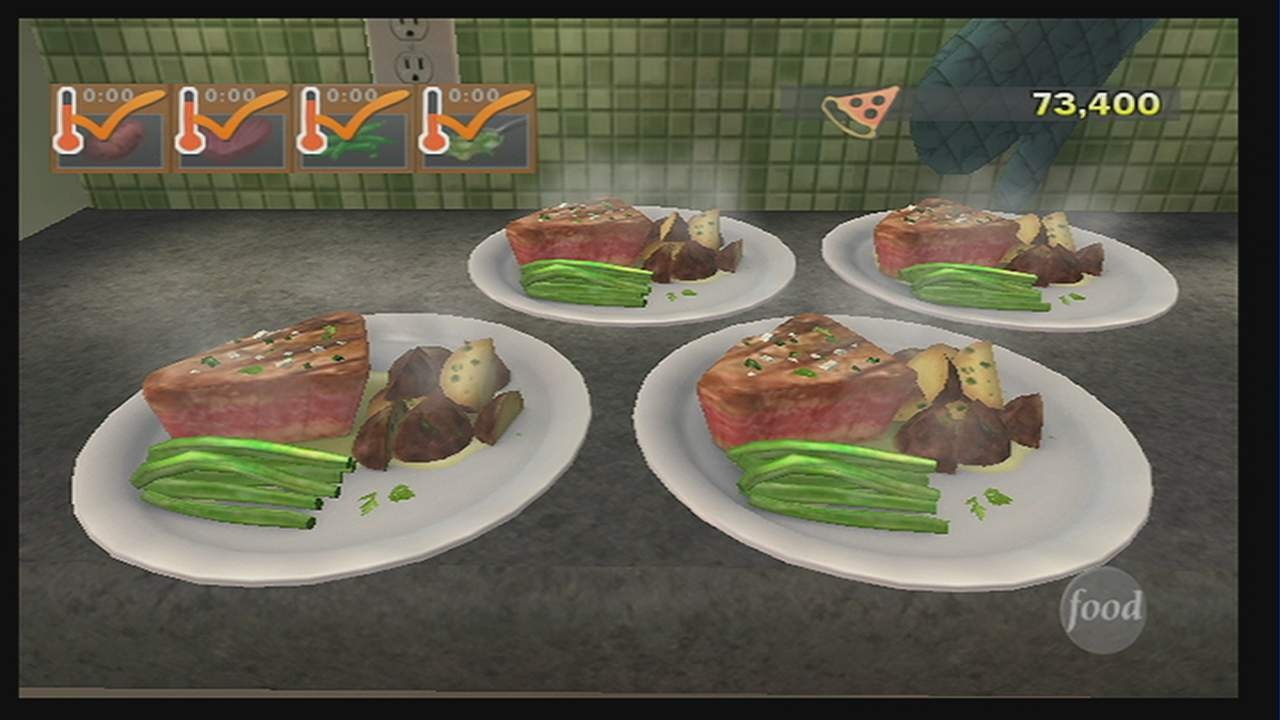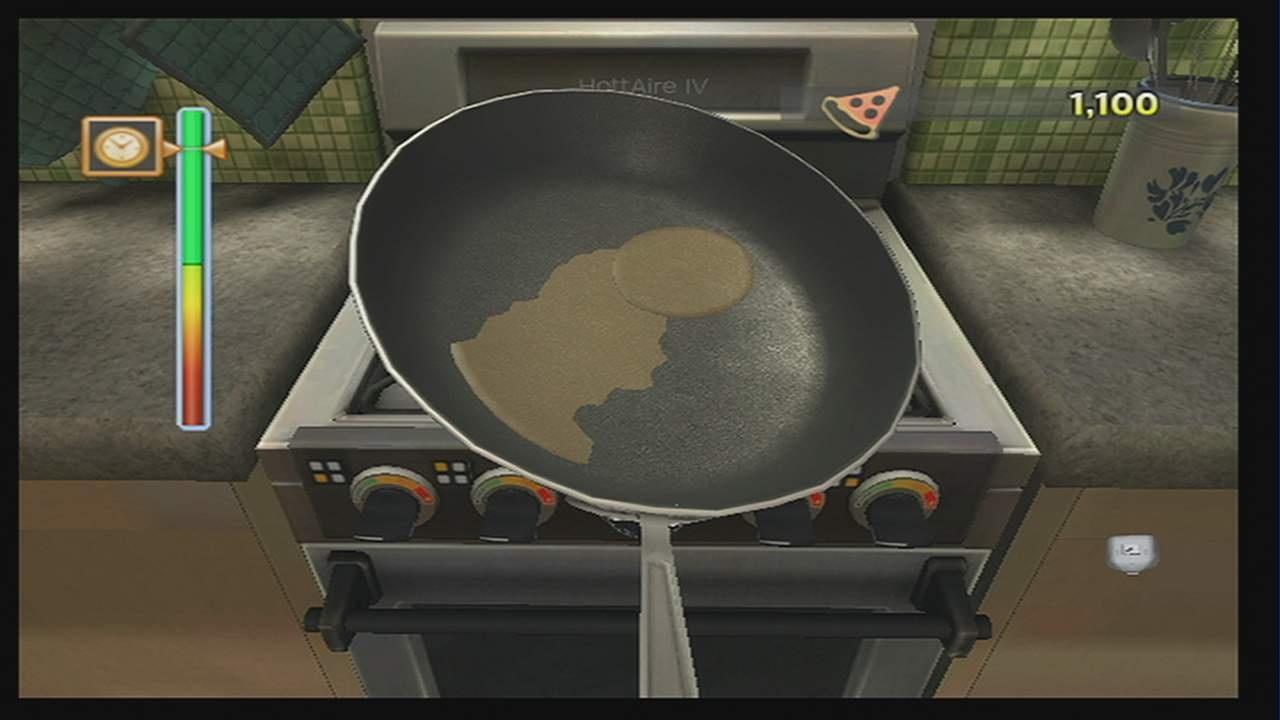The Food Network has built its success on a combination of celebrity chefs and shows that make seemingly intimidating cuisine accessible to the average viewer. As the first game bearing the Food Network title, Cook or Be Cooked focuses on the latter half of that formula. It doesn't feature any famous chefs like Emeril Lagasse pumping up an audience with catchphrase upon catchphrase, but it does offer a fun course in cooking techniques using simple, mostly intuitive motion controls. As you prepare, cook, and serve a variety of appetizing meals, two of the network's lesser-known personalities keep you invested in what's going on with a constant stream of feedback and interesting details about what you're making. A limited selection of recipes significantly hampers its value, but Cook or Be Cooked is nonetheless a game that will leave you eager to test out what you've learned in a real kitchen.

Serving up the perfect meal in Cook or Be Cooked is a process that requires equal parts motion controls and careful planning. You start each meal with basic preparations, such as chopping vegetables, pouring ingredients into a mixing bowl, or coating a pan with olive oil. These tasks are executed with simple gestures like swiping down with the Wii Remote to mimic a knife's chop, twisting it in circles to mix ingredients, and tilting it in multiple directions to let the oil flow evenly to uncoated areas of a pan. For the most part, these controls are extremely easy, but the way the game combines these motions to convey the sensation of a meal coming together bit by bit keeps you feeling like your work is really building up to something.
Adding some strategy to those breezy motion controls is the timing system. Each meal consists of multiple dishes, most of which have to be served up nice and hot. That means you need to plan ahead and pace your cooking so that the hot dishes all finish up at roughly the same time, making sure nothing gets cold on the serving plate while you finish up the rest of the meal. This keeps you thoroughly invested in your preparations, leaving you alert and focused on all the timers. There's also a scoring system that judges your technique and measurements at every turn, ranging from how quickly you can peel and dice garlic to how quickly you take pancakes off the griddle once they turn that perfect shade of golden brown. Much of this comes in the form of quick little pop-ups telling you how slow or great something was, though you'll also hear the game's two hosts offering you constructive, mostly interesting feedback and eventually a final analysis on the finished meal. That this wait for judgment can often feel quite nerve-wracking says a lot about how invested you become in these meals.
This scoring system does a nice job of alleviating the tedium of basic tasks and making you feel attached to the food, but the system isn't without its faults. It will score you on everything you do, and that comprehensiveness can feel downright absurd at times. Having a host tell you that the speed at which you punch in numbers on a microwave could "use some work" or getting negative feedback for adding pasta to boiling water a half second too late goes a long way toward ruining the illusion of being in a kitchen. Likewise, contrived minigames like the rhythm challenge required to assemble a pan of lasagna also help to ruin that sense of immersion.

The meals you make in Cook or Be Cooked run the gamut from a simple plate of fried eggs and bacon to elaborate entrees like Tuscan lasagna and grilled ahi tuna with a Caribbean mojo sauce. Though the game's visuals are nothing remarkable, the food itself looks realistic and appetizing, likely leaving your stomach rumbling with hunger by the time a meal is complete. Unfortunately, the "30+ recipes" advertised on the box actually amount to a paltry 12 in-game meals to choose from. For example, the overly easy fried eggs and skillet bacon meal counts counts the eggs and bacon as two different recipes, which is still just one meal in the game no matter how much it pads the figure on the outside of the box. Thanks to this creative use of math, you'll be done with all the game's recipes before you know it--probably around three hours. Though you'll likely have picked up a handful of valuable new techniques along the way, the small selection limits the game's appeal. Beyond that, there's not much fun in going back to old recipes once you've learned them already.
Adding a bit more value to Cook or Be Cooked is a pair of multiplayer modes that let you work as a team or go head-to-head. There's a pass-the-controller mode that lets two to four players take turns on one meal, and a two-player split-screen cook-off that has two chefs going at it for the best overall point total. Neither one has a significant effect on the basic experience, though there's a certain level of entertainment in making sure your friend doesn't overcook the meatballs you assembled a moment earlier, or taunting him if he has left his salmon on the grill too long.
Cook or Be Cooked succeeds at offering an entertaining cooking experience in video game form. It uses uncomplicated motion controls to successfully mimic various tasks in the kitchen, and that simplicity is aided by a mostly helpful scoring and feedback system that keeps you focused on the job at hand. The result is a game that makes it fun to learn the basics of a new recipe before you try it out in your own kitchen. Though the limited number of dishes and extremely modest replay value is a major strike against its overall value, Cook or Be Cooked is a pleasing mixture of video game and recipe book.